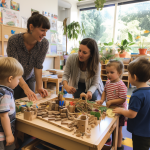Why learning a second language can help children’s development
It has been said that learning a second language at a younger age is far easier than learning it later on in life. Children absorb new information easier and quicker, therefore, if you are thinking of introducing a second language, introduce this sooner rather than later.
Learning a new language can increase children’s critical thinking, their creativity as well as providing children’s brains with new sounds and patterns.
If you are thinking of offering language sessions at your setting, think about how best to do this. Children are more receptive if these lessons are informal and play based. Children are more likely to absorb the information in a fun and enjoyable manner. Young children can sometimes be reluctant to try out their newly required language. During these times be patient and don’t force the child into doing something they don’t want to do.
Some people may think that by overloading children with more vocabulary can cause language confusion, language delay or a cognitive defect. When in fact it can help children maintain attention and help develop those core language skills.
As children become interested in their new language, they will begin to understand more about the different cultures. Being able to speak various languages can only be a positive especially as it can open up career opportunities
Here are a few reasons why learning a second language can help children’s development.
- As children absorb new language this can lead to greater cognitive development.
- When children learn a new language they become more aware of cultural diversity.
- Children who learn a second language are more likely to be successful with activities that require problem-solving.
- It can help children to develop the abilities to read, write and solve mathematical problems.
- Learning a second language helps children to recognise, negotiate meanings and communicate in different languages.
- As children are able to switch between using two languages this makes them good multitaskers.
If you are thinking of introducing language sessions here are a few top tips in teaching children a second language
- Make the whole experience fun.
- Use pictures and props to help children learn the new language.
- Use the different language during conversations.
- If you are able to, provide children with plenty of opportunities to play with children who speak the second language.
- Make the learning environment fun and interactive, introduce music and dance.
- Have resources in your room that allow children to practise their new language eg through the use of puppets and small world play.
- Promote storytelling in multiple languages.
- Maintain a positive attitude towards different cultures and languages children learn.
Introducing children to a second language will open up their learning opportunities for a child and possibly widen their careers opportunities later on in life.





Leave a Reply